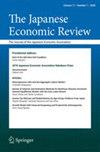空间古诺竞赛在一个有两个以上调度的圆形城市
IF 0.5
4区 经济学
Q2 ECONOMICS
引用次数: 2
摘要
本文研究了圆形城市中车辆最大服务范围小于周长一半,企业需要发起两次以上的调度来服务整个市场的空间古诺竞争。我们研究了一个多阶段的区位和运输方式选择博弈,以及随后双寡头企业之间的数量竞争。研究结果表明,当双寡头企业以不同的运输方式交付产品或运输方式决策是内生的且运输工具的固定成本较高时,非最大分散是唯一的区位均衡。本文章由计算机程序翻译,如有差异,请以英文原文为准。
Spatial Cournot competition in a circular city with more than two dispatches
This paper investigates spatial Cournot competition in a circular city, where the maximal service range of a vehicle is less than half of the perimeter, and a firm needs to initiate more than two dispatches to serve the whole market. We examine a multi-stage game of location and transportation mode choices, and the subsequent quantity competition between duopoly firms. The findings reveal that non-maximum dispersion is the unique location equilibrium when duopoly firms deliver products in different transportation modes or when the transportation mode decisions are made endogenously and the fixed cost of a transportation instrument is relatively high.
求助全文
通过发布文献求助,成功后即可免费获取论文全文。
去求助
来源期刊

Japanese Economic Review
ECONOMICS-
CiteScore
2.70
自引率
0.00%
发文量
15
期刊介绍:
Started in 1950 by a group of leading Japanese economists under the title The Economic Studies Quarterly, the journal became the official publication of the Japanese Economic Association in 1959. As its successor, The Japanese Economic Review has become the Japanese counterpart of The American Economic Review, publishing substantial economic analysis of the highest quality across the whole field of economics from researchers both within and outside Japan. It also welcomes innovative and thought-provoking contributions with strong relevance to real economic issues, whether political, theoretical or policy-oriented.
 求助内容:
求助内容: 应助结果提醒方式:
应助结果提醒方式:


